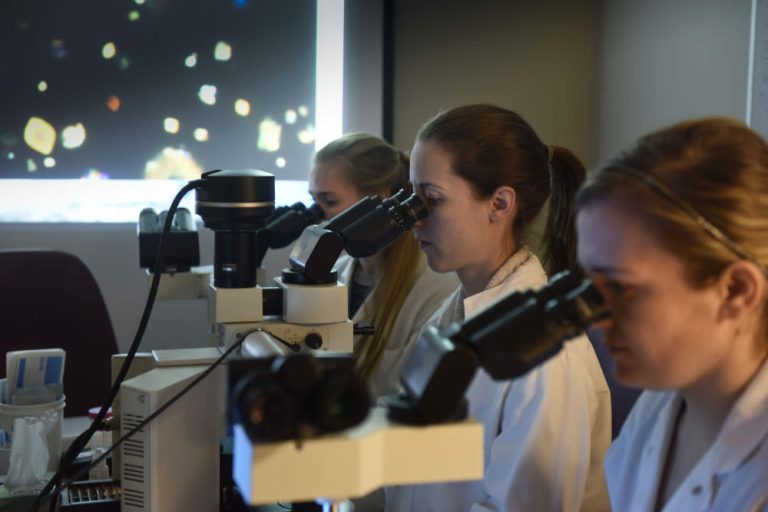Biosciences Industry in Minnesota Works at a Breakthrough Pace
Discover how bioscience and medical device companies in Minnesota are making rapid advancements for the future, breeding new startups, and creating life-changing discoveries in agriculture, medicine and beyond.

With deep roots in agricultural innovation, a rich history of technological breakthroughs and world-renowned research centers, Minnesota is a pacesetter across a swath of life sciences and biotechnology, from medical devices to pharmaceuticals to animal health.
While its pedigree includes the first mechanical heart valves and the first implantable cardiac pacemaker and infusion pumps – among other ground-breaking discoveries – the state’s biosciences sector is squarely focused on the future. Made up of 1,700 companies, Minnesota’s life-science, biotechnology and health technology cluster is one of the strongest in the world, generating billions of dollars in revenue each year.
Buoyed by Minnesota’s spirit of innovation, both homegrown companies (such as Medtronic and 3M) and those that have moved operations here (such as Boston Scientific) have formed a leadingedge, jobs-rich industry, breeding entrepreneurship while pioneering life-changing breakthroughs.
“Biotech, and tech companies in general, that are based in Minnesota enjoy a number of advantages, most notably our well-educated workforce and nation-leading quality of life,” says Margaret Anderson Kelliher, president and CEO of the Minnesota High Tech Association (MHTA), a nonprofit association of more than 300 tech companies and organizations. Minnesota also offers incentives such as tax credits that benefit tech companies, Kelliher says, including the Angel Tax Credit for startups and an R&D tax credit.
“All of this comes together to make Minnesota a fantastic place to start and locate a tech company,” she says.
From Clinic to Classroom
Mayo Clinic remains a key driver of bioscience advancement. Its presence alone makes Minnesota a global leader and has drawn a range of life sciences and research organizations into proximity.
Mayo isn’t the state’s only linchpin in the sector. The University of Minnesota (U of M) is a mainstay of life sciences
development. Researchers within the University’s 90-plus centers and institutes collaborate on discoveries, many of them taking place at U of M’s five-building Biomedical Discovery District.
The University attracted more than $1 billion in National Institutes of Health grants between 2010 and 2014. The U of M encourages entrepreneurial enterprise through various technology commercialization programs.
Just a few examples:
-
The Institute for Engineering in Medicine (IEM) bridges engineering and health sciences to create medical devices and promote collaboration with the private sector.
-
The Experimental Surgery Services designs and conducts research to determine the safety and efficacy of medical devices and gauge their readiness for regulatory submission.
-
The Institute for Therapeutics Discovery & Development conducts research, trains future scientists, and links academic and industrial partners to promote drug discovery and preclinical drug development.
An interdisciplinary approach is critical, says Dr. Bin He, Distinguished McKnight University Professor of Biomedical Engineering, Medtronic-Bakken Chair for Engineering in Medicine and director of IEM at the University.
IEM’s mission “requires interdisciplinary collaboration and approaches to tackle health and medicine problems using
engineering solutions,” he says.
IEM organizes its activities in five interdisciplinary themes: neuroengineering; cardiovascular engineering; cellular and molecular bioengineering; medical devices; and medical and biological imaging.
Work at the IEM has garnered significant NIH interdisciplinary grants totaling $12.5 million over the past two years.
“That has enhanced substantially what we do to discover and translate biomedical technology to clinical medicine,” he says.
Golden Opportunities
Minnesota’s device industry is creating entrepreneurial opportunities; nearly $246 million in venture funding flowed into the state’s medical-device industries in 2014 alone. An important subsector of the state’s biosciences industry is pharmaceutical and biologic, which spans human health microbiology, medical genomics, proteomics and stem-cell research. Minnesota companies and research institutions registered 493 patents in drugs and bio compositions between 2010 and 2014. Aiding their work is LifeScience Alley – with nearly 700 organizations representing all sectors of the life sciences ecosystem, including medical technology and equipment manufacturers, pharmaceutical and biopharmaceutical companies, health-care providers and insurers, agricultural and industrial biotechnology organizations, academic institutions and government entities, and a broad range of service and consulting companies. One of Minnesota’s many growing biomed companies is New Brighton-based Cardiovascular Systems, which develops solutions for treating vascular and coronary disease. The firm unveiled a $30 million headquarters expansion in 2014.
The state’s reputation as an agriculture leader has cultivated a robust animal health sector, encompassing leadership in animal nutrition (Cargill, Land O’Lakes), vaccines, biologics and more. A core group of major research centers are lending a leg up to animal-health advancements.
In every aspect of life sciences, leaders like Margaret Anderson Kelliher say the potential remains limitless.
“Our goal at MHTA is to make Minnesota a top five science and technology state, so we’re thrilled to see all of this great growth and innovation in the biotech industry,” she says. “As a community, we need to continue to foster innovation and ensure all tech companies have what they need to grow here in Minnesota.”
